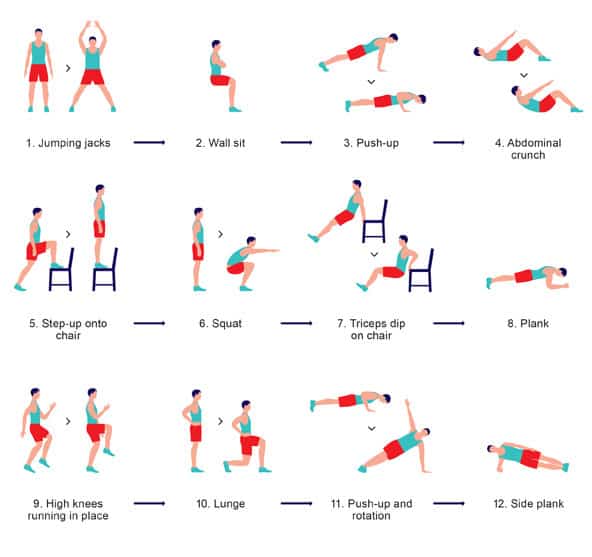
 Can a 7 minute workout really help? The short, intense workout is undergoing something of a revival these days. Today’s programs, however, come with one big difference: instead of slick pitch aired late at night when TV advertising space is cheap and potato chip consumption is high, these sweaty routines are backed by science.
Can a 7 minute workout really help? The short, intense workout is undergoing something of a revival these days. Today’s programs, however, come with one big difference: instead of slick pitch aired late at night when TV advertising space is cheap and potato chip consumption is high, these sweaty routines are backed by science.
You don’t have to go far to find the evidence. Study after recent peer reviewed study has found that high-intensity, short duration exercise (sometimes called HIT training) can be as good or better than a long slow jog or bike ride.
This is welcome news to busy-slash-lazy people like me. Even though my schedule is more self-directed than most, I still seem to end up with too many days when 8pm finds me purposelessly peddling in front of a basketball game, trying to salvage a symbolic victory for my health. Most nights, I barely break a sweat.
During a recent vacation with my wife, I decided to put one of these workouts to the test, with the idea that I could incorporate it into my everyday schedule if it worked. A quick search for a quick workout yielded a perfect result: “The Scientific 7-Minute Workout”, a routine that was published in the American College of Sports Medicine’s Health & Fitness Journal.
The New York Times Magazine picked up on several HIT workouts and of you Google variations of the keywords “short” “intense” and “workout you will invariably find them. Thus, the title of this piece is a misnomer, but it’s one that will reach the intended audience, as tens of thousands of people every month search for “NY Times 7 Minute Workout”. The routine was developed by Chris Jordan and Brett Klika from the Human Performance Institute in Orlando, Florida and was published in ACSM’S Health & Fitness Journal in June of 2013. It claims that elevating the heart rate and limiting rest time allows for greater gains in a limited time, resulting in body fat and body weight loss, and an improved VO2 max.
The routine is just twelve exercises that require no special equipment, outside of a chair and a wall. Over the course of a week, I memorized the diagram and did the routine in a cramped hotel room, in the living room of a condo, and on a floating dock in Algonquin Park, a testament to its versatility. The authors say using body weight as resistance may remove some of the obstacles some people have to getting fit, such as getting to a gym. Each exercise is performed for thirty seconds because Jordan and Klika claim this is a time that most participants can maintain intensity for. The routine is no joke: the movements are difficult to maintain for even a half-minute, particularly the plank and side planks, which most yoga enthusiasts will know, and the chair sit, which I suspect was the source of lower body soreness the day after my first workout. The authors say it is important to do the exercises in the same order as the diagram because it allows for opposing muscle groups to alternate between resting and working.
I must admit I made one major adjustment on my very first day with the routine. I simply felt, admittedly from gut instinct and not science, that there was no way despite the best efforts of the researchers that this amount of exercise could be enough for anyone, especially those looking to lose weight. By my estimation, the seven minute routine could only, at best, burn 150 to 200 calories. Doing the routine three times solves this somewhat, but I see the 7 Minute Workout” (or rather my modded 21 minute version) as the more intense of two workouts each day. The routine could be paired with a long walk in the evening, a slow bike ride, or, in the case of one day on my vacation, 18 holes of golf with a pull cart.
The 7 Minute Workout seems to me to be the perfect workout to do first thing in the morning, The routine gets you sweaty quickly, and could easily fit into a pre-work window normally reserved for coffee, After completing my cycle of three I felt completely relaxed and mentally sharp. My blood pressure and resting heart rate were lower. I felt different and much better than the times I have done a slow, 45-minute ride on a stationary bike. After a quick shower and a coffee afterward, I felt like this was an ideal way to begin a day and the calming effect was long-lasting.
After completing the workout on my last day in Algonquin Park, which was the seventh day of the routine, I wondered if this science backed seven minute routine represented the peak of the compact workout craze. Does a workout exist that could deliver a better result in shorter amount of time. My mind settled on one that is admittedly difficult to create. But I await the peer reviewed study: “Being chased by a bear: how this six minute routine can tone and shapen.”, with anticipation.
Below: The Scientific 7-minute Workout
Leave a Reply
You must be logged in to post a comment.




 Share
Share Tweet
Tweet Share
Share




Comment